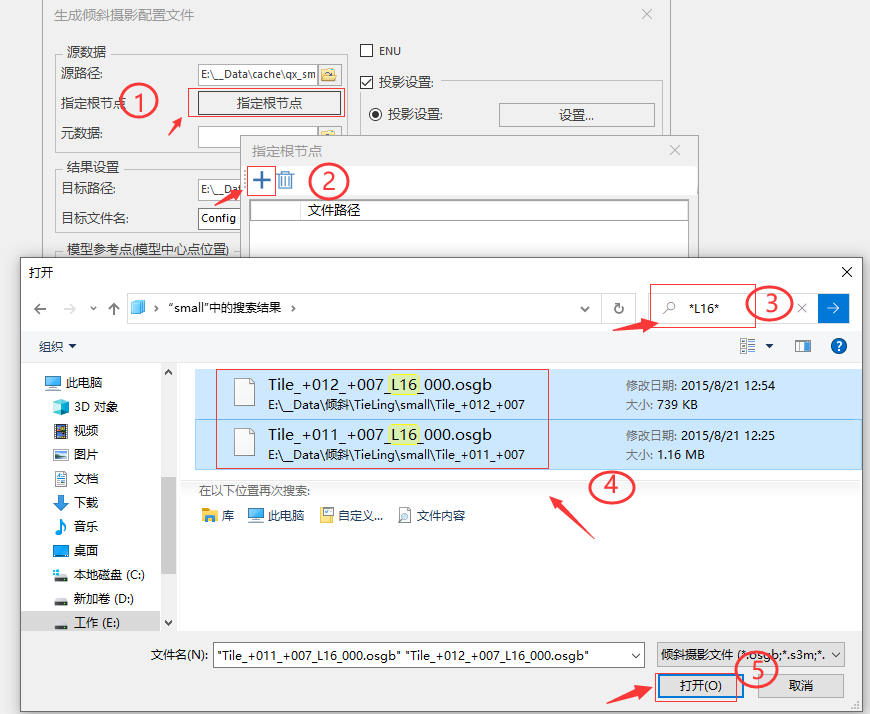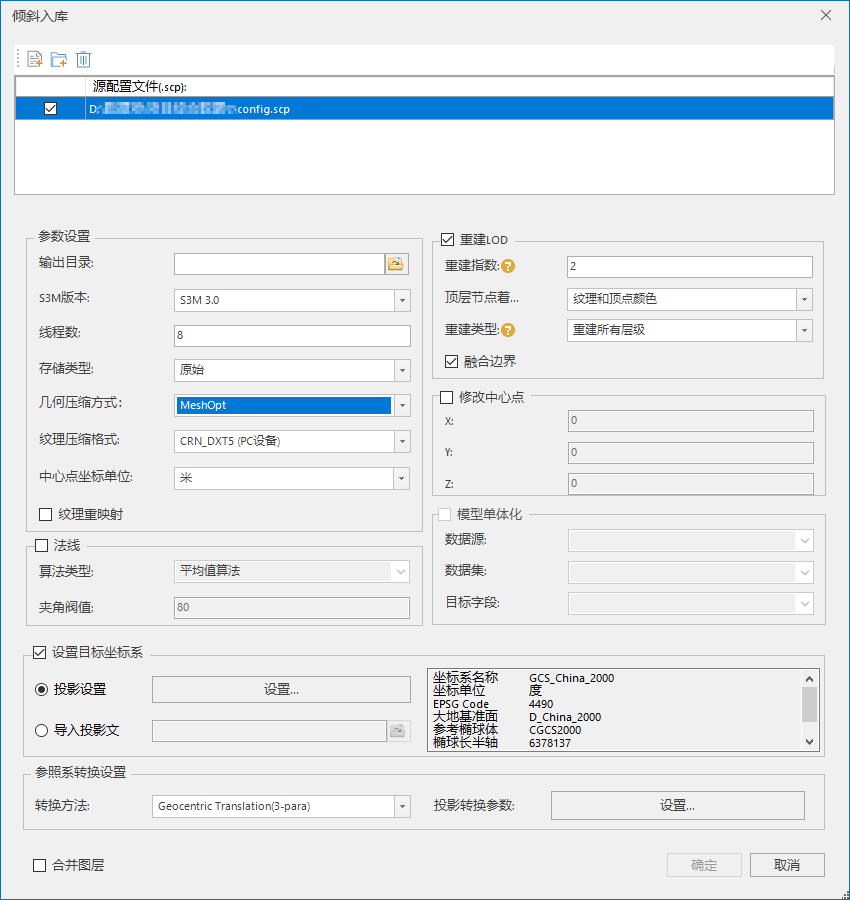Large-Scale Oblique Photography Data Processing Scheme
Understand the data
1、General data: A Tile folder is a root node, the name of the root node is the same as the name of the folder, and the LOD level increases sequentially. The desktop is processed normally and there are no special requirements.
2、Inconsistent data start level: The start level of the data root node under the folder is different, some are L14, some are L15. To generate a configuration file using the desktop, you need to specify a root node, which is the roughest level that all folders have.
3、Large data texture: The original data has a large texture, which causes the generated s3mb to be particularly large, which affects the loading performance. When tilting into the warehouse, the parameters need to be set to Draco for the geometry compression method and crn_dxt5 for the texture compression format.
4、The utilization rate of texture images is relatively low: when tilting into storage, select texture remapping.
hardware
It is recommended to use a solid-state drive to increase the processing speed. The processing time of using a common disk is 3 times longer than that of a solid-state drive.
open log
In the SuperMap.xml file under the component Bin directory, add a new label in the last line of the valid label, <BuildObliqueCombineErrorLog>TRUE</BuildObliqueCombineErrorLog>
During data processing, a log file will be generated in the output folder, and a If there is an exception, you can check the modified file to troubleshoot the problem. Log files are automatically deleted after the skew data processing is completed.
generate configuration file
(1).For the general method of generating a configuration file, please search for the keyword "generating a configuration file" in the desktop documentation, and refer to the generating configuration file document, which will not be introduced here.
(2).Specify the root node to generate a configuration file. Here, the data at the L16 level is specified as the root node as an example.

Tilt storage parameter setting

(3).In the "Source configuration file" of the dialog box, click "Add scp configuration file", in the pop-up "Open" dialog box , select a *.scp file, or add a source configuration file by clicking the "Open all scp files in this folder" button.
(4).In the "Parameter Settings" of the dialog box, the parameter settings are as follows:
- Output directory: Set the storage path of the result data.
- S3M version: supports three S3M versions, S3M1.0, S3M2.0, S3M3.0, it is recommended to use the latest S3M3.0. If you are using a WebGL package prior to 10.21 load the skewed cache file. It is recommended to use S3M1.0 when tilting into the warehouse.
- Number of threads: Set the number of threads for tilt storage operation, the default is 8.
- Storage type: If oblique photography needs to be encrypted, the storage type must be compact. If you store tilted cache files in MongoDB, the storage type must be primitive.
- Geometric compression methods: Currently, four compression methods are provided, and the time required for compression is in order from shortest to longest: no compression, conventional compression, Draco compression, and MeshOpt.
- Texture compression: The default is DXT (PC equipment), currently supports five compression formats: WebP, DXT (PC equipment), CRN_DXT5 (PC equipment), standard CRN, KTX2.0. For data with different purposes, different texture compression methods can be used to reduce the amount of video memory used by texture images.
- WebP: A common compressed texture format for the Web/PC. The total amount of data is reduced and the transmission performance is improved.
- DXT (PC device): A common compressed texture format for PCs (personal computers). The video memory usage is reduced and the rendering performance is improved, but the total amount of data will increase.
- CRN_DXT5 (PC device): It is a common compressed texture format suitable for PCs (personal computers). The memory usage is slightly reduced, and the total amount of data is greatly reduced, but it takes a long time to process .
- Standard CRN: Reduce video memory usage and reduce the total amount of data. It takes longer than CRN_DXT5 to process the same data.
- KTX2.0: Reduce video memory usage and reduce the total amount of data. It takes longer than standard CRN to process the same data.
- Center point coordinate unit: Set this parameter according to the configuration file center point coordinate unit. For example: if the coordinate unit of the center point of the original configuration file is METER, then select meters for this parameter.
- Texture remapping: It is used to solve the unreasonable texture stitching in some oblique data and improve performance. It is not checked by default.
(5). In the dialog box "Modify center point": optional, after checking "Modify center point", set the X, Y, and Z coordinates of the model center point.
- The coordinates of the oblique photographic model are determined by the label of the configuration file (*.SCP) and the coordinate information of the data itself. When loading multiple data of the same survey area, each data has its own center point coordinates, so Multiple SCP configuration files need to be loaded separately. "Modify model center point" is used to solve the problem of multiple center points of oblique photography data in the same survey area by modifying the coordinate information of the data itself, and realize the requirement of loading all data in one SCP configuration file. Not only that, it also supports multiple models in batches Modify the center point.
(6). In the "Rebuild LOD" dialog box: After checking "Rebuild LOD", set the rebuild index. The reconstruction index is used to set the number of merges, the default value is 1, and the system will rebuild a block file by 4^n blocks. After checking "Boundary Fusion", the boundary effect between the oblique photographic data tiles can be weakened, mainly for oblique photographic data with a small amount of intersecting tile boundaries.
(7). Reconstruction type: Rebuild all levels is used for reconstruction levels of the original OSGB oblique photographic model. Rebuilding only the top layer is to re-designate the finer layer data as the new root node for the S3MB data whose top layer effect is not good after reconstruction, and then rebuild the top layer.
(8). In the dialog box "Model Singularization": Optional, after checking "Model Singularization", set the data source where the vector surface superimposed on the model is located , dataset, and target field. For details, please refer to "Compress and Single" in SuperMap iDesktop 11i Help.chm.
(9).Projection settings currently provide two methods:
- Projection Settings: Get or set the original coordinate system of the data. When the "Projection Settings" radio button is selected, click the "Settings..." button on the right to pop up the "Coordinate System Settings" dialog box, and select a projection as the coordinate system of the target file. For the specific operation of setting the target projection, please refer to "Projection Settings" in SuperMap iDesktop 11i Help.chm.
- Import projection file: When selecting the "Import projection file" radio button, click the file browser icon button on the right, and in the pop-up "Selection" window, select the projection information file and import it Can. At the same time, the coordinate system details of the selected projection file will be displayed in the lower text box.
(10). After setting the above parameters, click the "OK" button and wait for the completion of the tilt storage.
FAQ
1. The data has been processed for one day, but there is still nothing in the output folder?
Answer: In the first stage of tilt storage, it will take time to read the information of all node data.
2. Crash during data processing?
Answer: Before data processing, open the SuperMap.xml file in the component Bin directory, add a new label to the last line of the valid label, and after <BuildObliqueCombineErrorLog>TRUE</BuildObliqueCombineErrorLog> crashes,
Open the log file in the output folder, find the osgb file recorded in the log, and use third-party software such as osgviewer to open it to confirm whether it is a data problem.
3. After data processing, how to determine whether there is a spatial index? Is the file index file correct?
Answer: There are many json files in the generated data folder, and the json files are very small, basically no more than 1M.
4. How much data is generated in one hour?
Answer: 64G memory, 16 cores, about 20G data generated in one hour. (It will be different from data accuracy and machine processing speed)
5. When is it recommended to use draco and crn_dxt5 compression?
Answer:
- ①After the default dxt format is processed, the generated s3mb file is relatively large (more than 6M files are more)
- ②The network bandwidth is relatively small, and the network file transfer is slow
6. How does draco and crn_dxt5 compression, generation time and data size compare with the default format (texture compressed dxt, geometry not compressed)?
Answer:
- ①The generation time is basically 3 to 4 times that of the default format
- ②The processed data size is about one-third of the default format
Notes:
1. The source data of oblique warehousing supports data in OSGB format. At the same time, 11i (2022) and above versions support oblique data in S3MB format to be re-stored.
2. The oblique warehousing function currently supports data in ENU and projected coordinate systems, but does not support data in planes without projected coordinate systems.
3. The oblique warehousing function only supports the coordinate transformation of the unified reference ellipsoid (projection to geography), and does not support other coordinate system transformations.